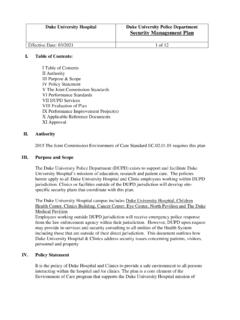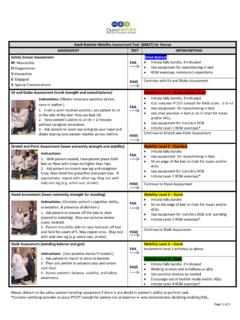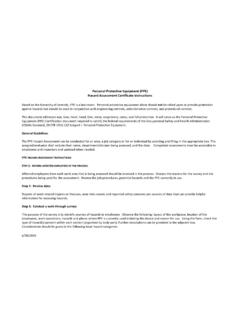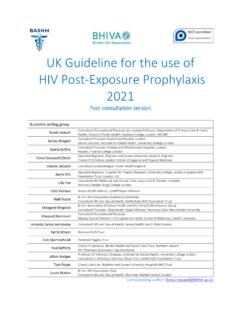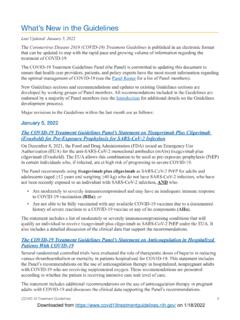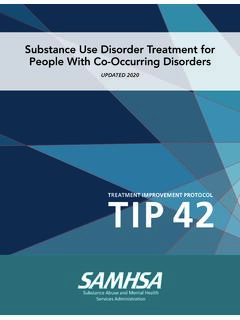Transcription of Post Exposure Evaluation and Follow-Up Procedures
1 14 APPENDIX C post Exposure Evaluation and Follow-Up Procedures HEPATITIS B VACCINATION Employees who fall under this standard are required by the institution to have a placement health review at Employee Occupational Health and Wellness (EOHW). At the time of the health review, the employee will be provided with pertinent information about the hepatitis B vaccine and it will be determined whether or not the employee falls under the exemptions for offering the vaccine. If the employee is not exempt, the vaccine will be offered. If the employee does not want to start the series at that time, he/she will be asked to read and sign the declination form and be given instructions that the vaccine will be available should he change his mind.
2 The hepatitis B vaccine is administered according to the Centers for Disease Control and Prevention (CDC) Guidelines (MMWR, vol 50, no. RR-11, June 29, 2001; available via internet at ). It is the employee's department that is responsible for making certain the employee goes through this process within 10 working days of initial assignment. post BLOOD/BODY FLUID Exposure Evaluation AND Follow-Up Exposure Definition Significant Exposure includes contamination by blood or other body fluids or high titers of cell-associated or free virus via 1) percutaneous, , needlestick; 2) permucosal, , splash in eye or mouth; or 3) cutaneous Exposure , , nonintact skin, or involving large amounts of blood or prolonged contact with blood, especially when exposed skin is chapped, abraded, or afflicted with dermatitis.
3 Employee Exposure A 24-hour hotline number is available at 115 (Duke phone system) or 684-8115 (off-site service) for immediate Evaluation of exposures by EOHW staff. The Exposure will be reviewed. Hepatitis B virus (HBV), hepatitis C (HCV), and human immunodeficiency virus (HIV) infection status of the source patient will be specifically investigated but the presence of other bloodborne diseases will be evaluated and appropriate protocols instituted, as needed. Examples of these disease include malaria, syphilis, babesiosis, brucellosis, leptospirosis, arboviral infections, relapsing fever, Creutzfeld-Jakob disease, HTLV-1, and viral hemorrhagic fever.
4 15 Information regarding all human blood or body fluid exposures is entered into the EOHW blood/body fluid Exposure surveillance database (National Surveillance System for Hospital Healthcare Workers, otherwise known as NaSH). Information includes the type, brand, and purpose of device involved in the incident (if known), the location where the incident occurred, the occupation of the injured employee, an explanation of how the injury occurred, and the source material s infectious status. This data forms the basis for the Duke University Medical Center Sharps Injury Log. 16 Duke University Employee Occupational Health & Wellness BBF PROTOCOL: HEPATITIS B Exposure PROTOCOL Exposure DEFINITION Significant Exposure includes blood or other body fluid contamination via percutaneous route, , needlestick; mucosal contact, , splashed in eye or mouth; or open skin area.
5 EMPLOYEE Exposure EOHW staff will review the Exposure . Other blood or body fluid Exposure protocols will be instituted, as indicated. Check HBsAg status of patient source. l. Unvaccinated employee A. Source known HBsAg (+) 1. Administer single dose of HBIG ( ml/kg body weight within 24 hours, if possible). 2. Start Hepatitis B Vaccine series. Note: If Exposure is >7 days, do not give HBIG; start Hepatitis B vaccine series if within reasonable proximity of Exposure . HBIG s value >7 days post Exposure is unclear. B. Source known, HBsAg (-) 1. Start Hepatitis B vaccine series. C. Source known, HBsAg status undetermined 1.
6 High risk that source is HBsAg (+), , patients with high risk of HBV carriage or patients with acute or chronic liver disease (serologically undiagnosed). a. Administer single dose of HBIG. b. Start Hepatitis B vaccine series. 2. Low risk that source HBsAg (+) a. Start Hepatitis B vaccine series; categorized as unknown source . D. Source unknown 1. Start Hepatitis B vaccine series; Categorized as unknown source . ll. Vaccinated employee 17 A. Source known, HbsAg (+) 1. Employee completed all 3 doses. a. If known responder, no treatment. b. If antibody response unknown, test employee and if adequate, no treatment c.
7 If antibodies inadequate on testing or employee has previously not responded to vaccine, administer single dose of HBIG immediately; (no later than 7 days post Exposure ) and a booster dose of Hepatitis B Vaccine or HBIG x2 1 month apart if employee has failed to respond to at least 4 doses of HBV. 2. Employee completed 1 or 2 doses a. Administer single dose of HBIG immediately and continue on schedule with vaccine series. HBsAb can be tested after 2 doses of HBV. B. Source known, HBsAg (-) 1. No testing or treatment. C. Source known, HBsAg status undetermined 1. High risk that source is HBsAg(+) a.
8 Employee has completed all 3 doses 1) If known responder, no treatment. 2) If antibody response unknown, test employee and if adequate, no treatment 3) If antibodies inadequate on testing or employee has previously not responded to vaccine, administer single dose of HBIG immediately; (no later than 7 days post Exposure ) and a booster dose of Hepatitis B vaccine or HBIG x2 if employee has failed to respond to at least 4 doses of HBV. b. Employee has received 1 or 2 doses of vaccine 1) Administer single dose of HBIG immediately and continue on schedule with vaccine series. HBsAb can be tested after 2 doses of HBV.
9 2. Low risk that source is HBsAg (+). a. If employee has completed series (3 doses), may request testing for HBsAb; otherwise no further testing or treatment; categorized as unknown source . D. Source unknown 18 1. If employee has completed series (3 doses), may request testing for HBsAb; otherwise no further testing or treatment; categorized as unknown source . The option of giving one dose of HBIG and reinitiating the vaccine series is preferred for non-responders who have not completed a second 3 dose vaccine series. For persons who previously completed a second vaccine series but failed to respond, 2 doses of HBIG are preferred.
10 INFECTED EMPLOYEE The purpose of these guidelines is to address health care workers (HCWs) who have active infection with Hepatitis B virus, Hepatitis C Virus, and/or Human Immunodeficiency Virus (HIV) (see HIV and HCV Protocols). HCWs infected with HBV shall inform EOHW of their status. Those who come to the attention of EOHW will be assessed individually as to risk of transmission in patient care setting. A confidential occupational assessment will be conducted by a committee made up of the chairperson of the HICC, the director of EOHW, and a member of the clinical faculty to be designated by the chief of the medical staff.



